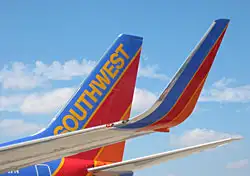
If your memory is really sharp, you may recall that last summer a hole opened up on a Southwest plane shortly after reaching cruising altitude. Fortunately, pilots were able to descend to lower altitudes and make an unscheduled landing.
Now, the National Transportation Safety Board (NTSB) has issued its findings from the incident. In its report, the NTSB says:
Post-incident examination of the airplane revealed fatigue cracking of the fuselage skin near the leading edge of the vertical stabilizer adjacent to the rupture. The fatigue cracking penetrated the fuselage skin and created an approximate 18-inch by 12-inch flap in the skin that depressurized the airplane.
The fuselage skin assembly near the leading edge of the vertical stabilizer was manufactured by bonding two full aluminum sheets together, then selectively chemically milling away pockets (bays) of the inner sheet. Continuous fatigue cracks initiated from multiple origins on the inner surface of the skin adjacent to the step formed at the edge of the chemically milled area and propagated outward.
The Associated Press (AP) adds, “FAA records showed that eight cracks had been found and repaired in the fuselage during the plane’s 14-year checkup six months before the [incident].”
So far, no blame has been assigned, and none may be forthcoming. More likely, the plane was simply old. According to the AP, “Southwest got the plane in 1994 — it’s much older than the average Southwest jet—and had flown it for 50,500 hours and made 42,500 takeoffs and landings before it sprang a hole in the roof.” Which is not to say that all 14-year-old planes should have this problem, just that, despite the incident, Southwest appears to have followed proper maintenance procedures.
As for Southwest, the airline issued the following statement:
We are in full compliance with all new Safety regulations developed by Boeing and the FAA and we thank the NTSB for its thorough investigation. We worked closely with investigators throughout this process and we concur with their conclusions. We’ve taken aggressive measures to incorporate additional maintenance inspections, additive to existing programs, in response to what was learned from flight 2294. Immediately after the accident, we increased our ongoing maintenance inspections in the impacted area to include recurring detailed visual inspections and non-destructive tests (NDT)–with a goal to not only meet but exceed known Safety standards.
So unless the NTSB is withholding more information, or a fine is still forthcoming, it appears this case is closed.
We hand-pick everything we recommend and select items through testing and reviews. Some products are sent to us free of charge with no incentive to offer a favorable review. We offer our unbiased opinions and do not accept compensation to review products. All items are in stock and prices are accurate at the time of publication. If you buy something through our links, we may earn a commission.
Related
Top Fares From
Today's Top Travel Deals
Brought to you by ShermansTravel
Kenya: 14-Night Tour, Incl. Tanzania &...
smarTours
 vacation
$7125+
vacation
$7125+
7-Night Caribbean Round-Trip Cruise From Orlando:...
Norwegian Cruise Line
 cruise
$789+
cruise
$789+
Ohio: Daily Car Rentals from Cincinnati
85OFF.com
 Car Rental
$19+
Car Rental
$19+



